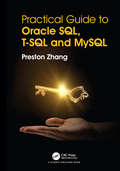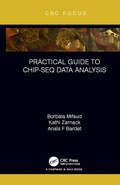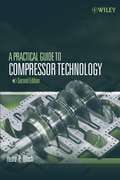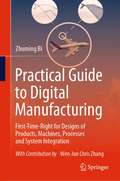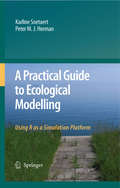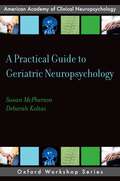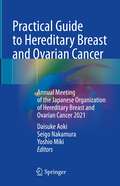- Table View
- List View
Practical Guide for Oracle SQL, T-SQL and MySQL
by Preston ZhangSQL is a widely used to access most databases, therefore database developers and system administrators should be familiar with it. This hands-on SQL book will help beginner and intermediate users to write queries that apply complex conditions on a table. The book's unique side by side approach makes it easy for the reader to learn three major query languages in the IT industry. The author has over 20 years of experience in database design. KEY FEATURES: Contains numerous practical screenshots of Oracle SQL, T-SQL, MySQL statements and results. Shows the differences between Oracle SQL, T-SQL and MySQL side by side. Gives a real world experience for SQL developers and database administrators. Sample data is available to work on (available on our website).
Practical Guide for Oracle SQL, T-SQL and MySQL
by Preston ZhangSQL is a widely used to access most databases, therefore database developers and system administrators should be familiar with it. This hands-on SQL book will help beginner and intermediate users to write queries that apply complex conditions on a table. The book's unique side by side approach makes it easy for the reader to learn three major query languages in the IT industry. The author has over 20 years of experience in database design. KEY FEATURES: Contains numerous practical screenshots of Oracle SQL, T-SQL, MySQL statements and results. Shows the differences between Oracle SQL, T-SQL and MySQL side by side. Gives a real world experience for SQL developers and database administrators. Sample data is available to work on (available on our website).
A Practical Guide for Pediatric Nuclear Medicine
by Zvi Bar-Sever Francesco Giammarile Ora Israel Helen NadelThis open access book will provide a foundation for the understanding of, and knowledge for a successful routine use of diagnostic Nuclear Medicine procedures in children through expertise and cases provided by representative busy pediatric nuclear medicine facilities. The book highlights important aspects of nuclear medicine in children and the differences between adult and pediatric practice where relevant.An introductory chapter provides general information detailing the advantages and limitations for performing nuclear medicine tests in children, as well as suggestions on how to approach and provide relevant data to the patients, their parents or next of kin. In the remaining 11 chapters, containing over 115 cases of children evaluated for various clinical indications, procedures are presented and subsequently detailed according to their clinical significance or prevalence based on the clinical experience of the contributors. The book is organized by organ systems, and also includes chapter on oncology and infection/ inflammation. Chapters are formatted to provide information regarding clinical indications, preparation including radiopharmaceutical doses and additional medications, study protocol, study interpretation, correlative imaging. Each chapter will include red flags warning and take home messages sections to emphasize important points. The case format is presented with patient history and then study report and impression.Based on practices explored by experts at the forefront of this field, the publication is directed at Nuclear Medicine physicians, radiologists, oncologists and clinicians in various pediatric specialties, medical physicists, medical technologists, radiopharmacists, laboratory medicine scientists and researchers.
A Practical Guide on Behaviour Change Support for Self-Managing Chronic Disease
by Mara Pereira Guerreiro Isa Brito Félix Marta Moreira MarquesThis open access book is a valuable resource for students in health and other professions and practicing professionals interested in supporting effective change in self-management behaviors in chronic disease, such as medication taking, physical activity and healthy eating.Developed under the auspices of the Train4Health project, funded by the Erasmus+ program of the European Union, the book contains six chapters written by international contributors from different disciplines. Chapter one introduces the competencies necessary for delivering effective behavior change support, based on an established program of work, and related learning outcomes. The four following chapters describe how these competencies can be acquired, focusing on concepts and theories, assessing self-management behaviors, implementing change strategies and person-centered communication, using a practical approach. The last chapter points out supplementary learning resources, developed as part of the Train4Health project.
A Practical Guide to Atmospheric Simulation Chambers
by Jean-François Doussin Hendrik Fuchs Astrid Kiendler-Scharr Paul Seakins John WengerThis open access title presents atmospheric simulation chambers as effective tools for atmospheric chemistry research. State-of-the-art simulation chambers provide unprecedented opportunities for atmospheric scientists to perform experiments that address the most important questions in air quality and climate research. The book covers technical details about chamber preparation and practical guidelines on their usage, while also delivering relevant historical and contextual information. It not only serves as a key publication for knowledge transfer within the simulation chamber research community, but it also provides the global atmospheric science community with a unique resource that outlines best practice for the operation of simulation chambers. The authors summarize the latest advances in chamber interoperability and standard protocols in order to provide the research community and the next generations of scientists with a unique technical reference guide for the use of simulation chambers. The volume will be of great interest to researchers and graduates working in the fields of Atmospheric and Environmental Sciences.
A Practical Guide to Biomedical Research: for the Aspiring Scientist
by Peter Agger Robert S. Stephenson J. Michael HasenkamThis book advises and supports novice researchers in taking their first steps into the world of scientific research. Through practical tips and tricks presented in a clear, concise and step-wise manner, the book describes the entire research process from idea to publication. It also gives the reader insight into the vast opportunities a research career can provide. The books target demographic is aspiring researchers within the biomedical professions, be it medical students, young doctors, nurses, engineers, physiotherapists etc. The book will help aspirational inexperienced researchers turn their intentions into actions, providing crucial guidance for successful entry into the field of biomedical research.
A Practical Guide to Borehole Geophysics in Environmental Investigations
by W. Scott KeysBorehole geophysics is frequently applied in hydrogeological environmental investigations where, for example, sites must be evaluated to determine the distribution of contaminants. It is a cost-effective method for obtaining information during several phases of such investigations. Written by one of world's leading experts in the field, A Practical Guide to Borehole Geophysics in Environmental Investigations explains the basic principles of the many tools and techniques used in borehole logging projects. Applications are presented in terms of broad project objectives, providing a hands-on guide to geophysical logging programs, including specific examples of how to obtain and interpret data that meet particular hydrogeologic objectives.
A Practical Guide to Borehole Geophysics in Environmental Investigations
by W. Scott KeysBorehole geophysics is frequently applied in hydrogeological environmental investigations where, for example, sites must be evaluated to determine the distribution of contaminants. It is a cost-effective method for obtaining information during several phases of such investigations. Written by one of world's leading experts in the field, A Practical Guide to Borehole Geophysics in Environmental Investigations explains the basic principles of the many tools and techniques used in borehole logging projects. Applications are presented in terms of broad project objectives, providing a hands-on guide to geophysical logging programs, including specific examples of how to obtain and interpret data that meet particular hydrogeologic objectives.
Practical Guide to ChIP-seq Data Analysis (Focus Computational Biology Series)
by Borbala Mifsud Kathi Zarnack Anaïs F BardetChromatin immunoprecipitation sequencing (ChIP-seq), which maps the genome-wide localization patterns of transcription factors and epigenetic marks, is among the most widely used methods in molecular biology. Practical Guide to ChIP-seq Data Analysis will guide readers through the steps of ChIP-seq analysis: from quality control, through peak calling, to downstream analyses. It will help experimental biologists to design their ChIP-seq experiments with the analysis in mind, and to perform the basic analysis steps themselves. It also aims to support bioinformaticians to understand how the data is generated, what the sources of biases are, and which methods are appropriate for different analyses.
Practical Guide to ChIP-seq Data Analysis (Focus Computational Biology Series)
by Borbala Mifsud Kathi Zarnack Anaïs F BardetChromatin immunoprecipitation sequencing (ChIP-seq), which maps the genome-wide localization patterns of transcription factors and epigenetic marks, is among the most widely used methods in molecular biology. Practical Guide to ChIP-seq Data Analysis will guide readers through the steps of ChIP-seq analysis: from quality control, through peak calling, to downstream analyses. It will help experimental biologists to design their ChIP-seq experiments with the analysis in mind, and to perform the basic analysis steps themselves. It also aims to support bioinformaticians to understand how the data is generated, what the sources of biases are, and which methods are appropriate for different analyses.
A Practical Guide to Compressor Technology
by Heinz P. BlochA Complete overview of theory, selection, design, operation, and maintenance This text offers a thorough overview of the operating characteristics, efficiencies, design features, troubleshooting, and maintenance of dynamic and positive displacement process gas compressors. The author examines a wide spectrum of compressors used in heavy process industries, with an emphasis on improving reliability and avoiding failure. Readers learn both the theory underlying compressors as well as the myriad day-to-day practical issues and challenges that chemical engineers and plant operation personnel must address. The text features: Latest design and manufacturing details of dynamic and positive displacement process gas compressors Examination of the full range of machines available for the heavy process industries Thorough presentation of the arrangements, material composition, and basic laws governing the design of all important process gas compressors Guidance on selecting optimum compressor configurations, controls, components, and auxiliaries to maximize reliability Monitoring and performance analysis for optimal machinery condition Systematic methods to avoid failure through the application of field-tested reliability enhancement concepts Fluid instability and externally pressurized bearings Reliability-driven asset management strategies for compressors Upstream separator and filter issues The text's structure is carefully designed to build knowledge and skills by starting with key principles and then moving to more advanced material. Hundreds of photos depicting various types of compressors, components, and processes are provided throughout. Compressors often represent a multi-million dollar investment for such applications as petrochemical processing and refining, refrigeration, pipeline transport, and turbochargers and superchargers for internal combustion engines. This text enables the broad range of engineers and plant managers who work with these compressors to make the most of the investment by leading them to the best decisions for selecting, operating, upgrading, maintaining, and troubleshooting.
Practical Guide to Diagnostic Parasitology (ASM Books)
by Lynne Shore GarciaIn the 21st century the field of diagnostic medical parasitology continues to see dramatic changes, including newly recognized pathogens and the changing endemicity and classification of familiar organisms; neglected tropical diseases and the impact of global climate change; and new methodologies and risk management issues. This classic clinical laboratory parasitology reference, now in its third edition, has been extensively revised and updated in a new full-color format. Still organized to provide maximum help to the user, particularly from the bench perspective, every section has been expanded with new images and discussion. Specimen collection, preservation, and testing options are thoroughly discussed, from the routine ova and parasite examination to blood films, fecal immunoassays, and the newer molecular test panels. Specific test procedures, laboratory methods and reagents, and algorithms are provided. The ever-helpful “FAQ” section of commonly asked questions now offers expanded information on stool specimen fixatives and testing, thorough coverage of new techniques, and advice on reporting and commenting on results. The heart of the Guide, covering identification of individual pathogens, has been expanded with more discussion and comparison of organisms and dozens of new color images. An entirely new section has been added that uses extensive figures and new tables to illustrate common problems with differentiating organisms from one another and from possible microscopic artifacts. The final section has been reorganized to include identification keys and dozens of tables summarizing organism characteristics to assist the bench microbiologist with routine diagnostic testing methods.
Practical Guide to Diagnostic Parasitology (ASM Books #141)
by Lynne Shore GarciaIn the 21st century the field of diagnostic medical parasitology continues to see dramatic changes, including newly recognized pathogens and the changing endemicity and classification of familiar organisms; neglected tropical diseases and the impact of global climate change; and new methodologies and risk management issues. This classic clinical laboratory parasitology reference, now in its third edition, has been extensively revised and updated in a new full-color format. Still organized to provide maximum help to the user, particularly from the bench perspective, every section has been expanded with new images and discussion. Specimen collection, preservation, and testing options are thoroughly discussed, from the routine ova and parasite examination to blood films, fecal immunoassays, and the newer molecular test panels. Specific test procedures, laboratory methods and reagents, and algorithms are provided. The ever-helpful “FAQ” section of commonly asked questions now offers expanded information on stool specimen fixatives and testing, thorough coverage of new techniques, and advice on reporting and commenting on results. The heart of the Guide, covering identification of individual pathogens, has been expanded with more discussion and comparison of organisms and dozens of new color images. An entirely new section has been added that uses extensive figures and new tables to illustrate common problems with differentiating organisms from one another and from possible microscopic artifacts. The final section has been reorganized to include identification keys and dozens of tables summarizing organism characteristics to assist the bench microbiologist with routine diagnostic testing methods.
Practical Guide to Digital Manufacturing: First-Time-Right for Design of Products, Machines, Processes and System Integration
by Zhuming BiThis book covers the subject of digital manufacturing. It provides a practical guide for readers on using computer aided design (CAD), computer aided engineering (CAE) and computer aided manufacturing (CAM) and other computer assistive tools for the design of products, machines, processes and system integrations through the case studies of engineering projects. The book introduces a thorough theoretical foundation and discussion of the historical development, and enabling technologies of digital manufacturing. It also covers a broad range of computer aided tools for a variety of applications including: geometric modelling;assembly modelling;motion simulation;finite element analysis;manufacturing process simulation;machining programming;product data management; and,product lifecycle management. Practical Guide to Digital Manufacturing uses many real-world case studies to illustrate the discussed applications, making it easily readable for undergraduate and graduate students, as well as engineers with the needs of computer-aided design and manufacturing knowledge and skills.
A Practical Guide to Drug Development in Academia: The SPARK Approach
by Daria Mochly-Rosen Kevin Grimes"A lot of hard-won knowledge is laid out here in a brief but informative way. Every topic is well referenced, with citations from both the primary literature and relevant resources from the internet." Review of first edition from Nature Chemical BiologyWritten by the founders of the SPARK program at Stanford University, this book is a practical guide designed for professors, students and clinicians at academic research institutions who are interested in learning more about the drug development process and how to start transforming their basic research discoveries into novel drugs. Often many potentially transformative basic science discoveries are not pursued because they are deemed ‘too early’ to attract industry interest. This comprehensive book lays out simple, relatively cost-effective things that academic researchers can do to advance their findings to the point that they can be tested in the clinic or attract more industry interest.Each chapter broadly discusses an important topic in drug development, from discovery, optimization and preclinical studies through clinical trial design, regulatory issues and marketing assessments. After the practical overview provided here, the reader is encouraged to consult more detailed texts on specific topics of interest.The SPARK model has been adopted in over 60 institutions on six continents, and the program has been honored with multiple awards including the 2020 Xconomy Award for Ecosystem Development, the 2020 Cures Within Reach Award for Patient Impact Research, and the 2022 California Life Sciences Pantheon Award for Academia, Non-Profits, & Research.The new edition updates every chapter with the latest developments since the 2014 publication of the first edition.
A Practical Guide to Ecological Modelling: Using R as a Simulation Platform
by Karline Soetaert Peter M. HermanMathematical modelling is an essential tool in present-day ecological research. Yet for many ecologists it is still problematic to apply modelling in their research. In our experience, the major problem is at the conceptual level: proper understanding of what a model is, how ecological relations can be translated consistently into mathematical equations, how models are solved, steady states calculated and interpreted. Many textbooks jump over these conceptual hurdles to dive into detailed formulations or the mathematics of solution. This book attempts to fill that gap. It introduces essential concepts for mathematical modelling, explains the mathematics behind the methods, and helps readers to implement models and obtain hands-on experience. Throughout the book, emphasis is laid on how to translate ecological questions into interpretable models in a practical way.The book aims to be an introductory textbook at the undergraduate-graduate level, but will also be useful to seduce experienced ecologists into the world of modelling. The range of ecological models treated is wide, from Lotka-Volterra type of principle-seeking models to environmental or ecosystem models, and including matrix models, lattice models and sequential decision models. All chapters contain a concise introduction into the theory, worked-out examples and exercises. All examples are implemented in the open-source package R, thus taking away problems of software availability for use of the book. All code used in the book is available on a dedicated website.
A Practical Guide to Environmental Biotechnology (Learning Materials in Biosciences)
by Jayanta Kumar Patra Gitishree Das Swagat Kumar Das Hrudayanath ThatoiThis textbook provides practical guidelines on conducting experiments across the entire spectrum of environmental biotechnology. It opens with general information on laboratory safety, rules and regulations, as well as a description of various equipment commonly used in environmental laboratories. It then discusses in detail the major experiments in basic and advanced environmental studies, including the analysis of water and soil samples; the isolation, culture, and biochemical characterization of microbes; and plant tissue culture techniques and nutrient analyses. Each chapter features detailed method sections and easy-to-follow protocols, and offers guidance on calculations and formulas, as well as illustrative flow charts to assist with troubleshooting for each experiment. Given its scope, the book is an invaluable aid for laboratory researchers studying environmental biotechnology, and a rich source of information and advice for advanced undergraduates and graduates in the fields of environmental science and biotechnology.
Practical Guide to Finite Elements: A Solid Mechanics Approach
by Steven LepiAssuming only basic knowledge of mathematics and engineering mechanics, this lucid reference introduces the fundamentals of finite element theory using easy-to-understand terms and simple problems-systematically grounding the practitioner in the basic principles then suggesting applications to more general cases.Furnishes a wealth of practical insights drawn from the extensive experience of a specialist in the field!Generously illustrated with over 200 detailed drawings to clarify discussions and containing key literature citations for more in-depth study of particular topics, this clearly written resource is an exceptional guide for mechanical, civil, aeronautic, automotive, electrical and electronics, and design engineers; engineering managers; and upper-level undergraduate, graduate, and continuing-education students in these disciplines.
Practical Guide to Finite Elements: A Solid Mechanics Approach
by Steven LepiAssuming only basic knowledge of mathematics and engineering mechanics, this lucid reference introduces the fundamentals of finite element theory using easy-to-understand terms and simple problems-systematically grounding the practitioner in the basic principles then suggesting applications to more general cases.Furnishes a wealth of practical insights drawn from the extensive experience of a specialist in the field!Generously illustrated with over 200 detailed drawings to clarify discussions and containing key literature citations for more in-depth study of particular topics, this clearly written resource is an exceptional guide for mechanical, civil, aeronautic, automotive, electrical and electronics, and design engineers; engineering managers; and upper-level undergraduate, graduate, and continuing-education students in these disciplines.
A Practical Guide to Geriatric Neuropsychology (AACN Workshop Series)
by Susan McPherson Deborah KoltaiA Practical Guide to Geriatric Neuropsychology focuses on the skills required in testing and treating the older adult population. Topics discussed include normal aging, determining competency, important factors to consider in conducting clinical interviews, the importance of evaluating for depression and substance abuse, screening tools for use in practice, cognitive training and intervention and evaluation of the older adult in the workplace. This book will be helpful for neuropsychologists interested in testing and providing recommendations for older adults and for psychologists interested in treating older adults.
A Practical Guide to Geriatric Neuropsychology (AACN Workshop Series)
by Susan McPherson Deborah KoltaiA Practical Guide to Geriatric Neuropsychology focuses on the skills required in testing and treating the older adult population. Topics discussed include normal aging, determining competency, important factors to consider in conducting clinical interviews, the importance of evaluating for depression and substance abuse, screening tools for use in practice, cognitive training and intervention and evaluation of the older adult in the workplace. This book will be helpful for neuropsychologists interested in testing and providing recommendations for older adults and for psychologists interested in treating older adults.
A Practical Guide to Head Injury Rehabilitation: A Focus on Postacute Residential Treatment (Critical Issues in Neuropsychology)
by Michael D. Wesolowski Arnie H. ZenciusBehavioral neuropsychology presents at once achallenge and an opportunity for the field ofbehavior analysis. A great diversity of problem areas-including education, classroom management, child rearing, retardation, and industry have been treated effectively by the behavior analytic approach, which has traditionally and quite deliberately chosen to deemphasize physiology and cognitive variables. Yet brain injury, by its nature, entails neurological insult that is often closely related to specific cognitive dysfunctions. The challenge for behavior analysis is to develop effective treatments for a disorder with such clearly defined tripartite characteristics. The opportunity exists for be havior analysis to expand its conceptual basis as well as to provide benefits to patients otherwise despairing of assistance. Case histories demonstrate over 20 years of successful applications of behavior analysis to brain-injured in dividuals, indicating that some applications are possible, but are these reports notable exceptions or the harbingers of a new general therapeutic approach? The present book describes an overall focused behaviaral program far dealing with the diversity of brain injury problems in a general brain injury rehabilitation setting. The authors describe what types of neurological damage are associated with specific types of cognitive/emotional dysfunction and in turn with specific types ofbehavioral dysfunction, thereby demonstrating how the choice ofbehavioral treatment is guided by the neurological and subjective assessment. The result is a conceptually unified approach. The distinctive value of this book lies in the detail as well as the pro grammatic guidelines for actual implementation ofthis behavioral approach.
Practical Guide to Hereditary Breast and Ovarian Cancer: Annual Meeting of the Japanese Organization of Hereditary Breast and Ovarian Cancer 2021
by Daisuke Aoki Seigo Nakamura Yoshio MikiThis book shares cutting-edge evidence on Hereditary Breast and Ovarian Cancer (HBOC) treatment, delivering facts on breast cancer, gynecologic oncology, and basic research to contribute to clinicians' practices. Each chapter presents the latest clinical techniques, basic experimental results, and the best-chosen research findings. The book is based on the works presented at the Japanese Organization of Hereditary Brest and Ovarian Cancer (JOHBOC) and a special chapter delivers a study based on the extensive data from the Japanese HBOC patients registered in the society's database, presenting novel evidence for further advancement in the field. The practice for HBOC has been rapidly increasing due to the clinical development of poly(ADP-ribose) polymerase inhibitors and the spread of companion diagnostics. In addition, the insurance coverage of a part of HBOC treatment raised social awareness in Japan, and the book illustrates not only clinical efforts but also issues related to the social system and the efforts of the association of related organizations. Hereditary Breast and Ovarian Cancer – Annual meeting of JOHBOC will be of interest to breast surgeons, obstetricians and gynecologists, pancreatic cancer surgeons, and urologists engaged in HBOC treatment through the implementation of companion diagnostics for PARP inhibitors administration. Also, physicians occupied in genetic medicine who perform genetic testing and medical staff practicing HBOC will find this book insightful. It is also for HBOC patients and their families, medical administrators in the social system of HBOC practice. Editors and authors hope to contribute to the equalization and widespread of HBOC practice and serve as a foundation for future advances in the disease's treatment and medical practice.
Practical Guide to ICP-MS and Other Atomic Spectroscopy Techniques: A Tutorial for Beginners (Practical Spectroscopy)
by Robert ThomasWritten by one of the very first practitioners of ICP-MS, Practical Guide to ICP-MS and Other Atomic Spectroscopy Techniques: A Tutorial for Beginners presents ICP-MS in a completely novel and refreshing way. By comparing it with other complementary atomic spectroscopy (AS) techniques, it gives the trace element analysis user community a glimpse into why the technique was first developed and how the application landscape has defined its use today, 40 years after it was first commercialized in 1983. What’s new in the 4th edition: Updated chapters on the fundamental principles and applications of ICP-MS New chapters on complementary AS techniques including AA, AF, ICP-OES, MIP-AES, XRF, XRD, LIBS, LALI-TOFMS Strategies for reducing errors and contamination with plasma spectrochemical techniques Comparison of collision and reaction cells including triple/multi quad systems Novel approaches to sample digestion Alternative sample introduction accessories Comprehensive glossary of terms used in AS New vendor contact information The book is not only suited to novices and beginners, but also to more experienced analytical scientists who want to know more about recent ICP-MS developments, and where the technique might be heading in the future. Furthermore, it offers much needed guidance on how best to evaluate commercial AS instrumentation and what might be the best technique, based on your lab’s specific application demands.
Practical Guide to ICP-MS and Other Atomic Spectroscopy Techniques: A Tutorial for Beginners (Practical Spectroscopy)
by Robert ThomasWritten by one of the very first practitioners of ICP-MS, Practical Guide to ICP-MS and Other Atomic Spectroscopy Techniques: A Tutorial for Beginners presents ICP-MS in a completely novel and refreshing way. By comparing it with other complementary atomic spectroscopy (AS) techniques, it gives the trace element analysis user community a glimpse into why the technique was first developed and how the application landscape has defined its use today, 40 years after it was first commercialized in 1983. What’s new in the 4th edition: Updated chapters on the fundamental principles and applications of ICP-MS New chapters on complementary AS techniques including AA, AF, ICP-OES, MIP-AES, XRF, XRD, LIBS, LALI-TOFMS Strategies for reducing errors and contamination with plasma spectrochemical techniques Comparison of collision and reaction cells including triple/multi quad systems Novel approaches to sample digestion Alternative sample introduction accessories Comprehensive glossary of terms used in AS New vendor contact information The book is not only suited to novices and beginners, but also to more experienced analytical scientists who want to know more about recent ICP-MS developments, and where the technique might be heading in the future. Furthermore, it offers much needed guidance on how best to evaluate commercial AS instrumentation and what might be the best technique, based on your lab’s specific application demands.
